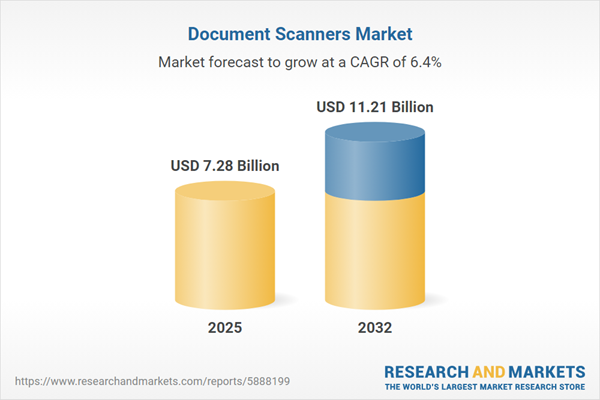Speak directly to the analyst to clarify any post sales queries you may have.
The document scanners market is rapidly evolving as organizations accelerate digital transformation, optimize workflows, and adapt to changing compliance and sustainability demands. This report delivers executive-level perspectives on the sector's growth catalysts, competitive strategies, and technological advancements, empowering senior decision-makers navigating investment and deployment decisions.
Market Snapshot: Document Scanners Market Size, Growth, and Outlook
The document scanners market grew from USD 6.84 billion in 2024 to USD 7.28 billion in 2025. It is projected to sustain momentum with a compound annual growth rate (CAGR) of 6.36%, reaching USD 11.21 billion by 2032.
Scope & Segmentation of the Document Scanners Market
This comprehensive analysis examines a range of segments and market dimensions, providing a granular view to support procurement and strategic planning:
- Type: Drum, Flatbed (A3, A4), Handheld, Mobile, Sheetfed (Duplex, Simplex)
- Technology: CCD, CIS
- Application: Commercial, Consumer
- End User: BFSI, Education, Government, Healthcare
- Resolution: 600 to 1200 DPI, Above 1200 DPI, Less than 600 DPI
- Connectivity: Bluetooth, Network, USB, Wireless
- Region: Americas (United States, Canada, Mexico, Brazil, Argentina, Chile, Colombia, Peru), Europe, Middle East & Africa (United Kingdom, Germany, France, Russia, Italy, Spain, Netherlands, Sweden, Poland, Switzerland, United Arab Emirates, Saudi Arabia, Qatar, Turkey, Israel, South Africa, Nigeria, Egypt, Kenya), Asia-Pacific (China, India, Japan, Australia, South Korea, Indonesia, Thailand, Malaysia, Singapore, Taiwan)
- Key Companies: Fujitsu Limited, Kodak Alaris Holdings Limited, Canon Inc., Seiko Epson Corporation, HP Inc., Brother Industries Ltd., Ricoh Company Ltd., Xerox Corporation, Konica Minolta Inc., Panasonic Corporation
Key Takeaways for Decision-Makers
- The document scanners market is driven by the shift from paper to digital, with robust integration across cloud and enterprise content management platforms.
- Artificial intelligence and optical character recognition advancements enable intelligent capture devices that facilitate more automated and insightful workflows for diverse business environments.
- Mobile and networked solutions, coupled with portable form factors, are supporting the demands of hybrid and remote workforces across geographies and operational setups.
- Manufacturers are addressing sustainability imperatives through eco-friendly materials, energy optimization, and compliance with environmental mandates in increasingly regulated markets.
- Strategic partnerships between hardware firms, software integrators, and cloud providers are enhancing product interoperability, supporting both modular upgrades and subscription-based 'scanning-as-a-service' deployment models.
- Regional market dynamics vary significantly. Digitization initiatives in Asia-Pacific are balanced by regulatory-driven adoption and upgrade paths in EMEA and modernization in the Americas.
Tariff Impact and Supply Chain Adaptation
Recent tariffs introduced in the United States in 2025 have altered scanner hardware and component costs, prompting supply chain recalibration. Companies are mitigating risks through enhanced local assembly, supplier diversification, and nearshoring. These strategies support long-term resilience, introduce modularity in design, and encourage supplier collaboration to manage short-term pricing and maintain market competitiveness.
Methodology & Data Sources
Insight is underpinned by a rigorous blend of in-depth C-suite interviews, structured surveys with procurement and IT professionals, and secondary research from peer-reviewed publications, regulatory filings, industry databases, and expert review. This multi-stage research approach ensures sector transparency and data reliability.
Why This Report Matters
- Enables informed technology adoption and vendor selection, minimizing implementation risks in a dynamic market.
- Guides strategic responses to evolving supply chain, compliance, and sustainability requirements across regions.
- Supports executive investment, procurement, and partnership decisions aligned with both near-term digital initiatives and long-term growth.
Conclusion
The document scanners market is transforming through digital innovation, changing operational models, and global shifts in supply chain and regulation. Senior leaders equipped with these insights can make forward-looking choices that drive efficiency, resilience, and competitive differentiation.
Additional Product Information:
- Purchase of this report includes 1 year online access with quarterly updates.
- This report can be updated on request. Please contact our Customer Experience team using the Ask a Question widget on our website.
Table of Contents
3. Executive Summary
4. Market Overview
7. Cumulative Impact of Artificial Intelligence 2025
Companies Mentioned
The companies profiled in this Document Scanners market report include:- Fujitsu Limited
- Kodak Alaris Holdings Limited
- Canon Inc.
- Seiko Epson Corporation
- HP Inc.
- Brother Industries, Ltd.
- Ricoh Company, Ltd.
- Xerox Corporation
- Konica Minolta, Inc.
- Panasonic Corporation
Table Information
| Report Attribute | Details |
|---|---|
| No. of Pages | 189 |
| Published | October 2025 |
| Forecast Period | 2025 - 2032 |
| Estimated Market Value ( USD | $ 7.28 Billion |
| Forecasted Market Value ( USD | $ 11.21 Billion |
| Compound Annual Growth Rate | 6.3% |
| Regions Covered | Global |
| No. of Companies Mentioned | 11 |









